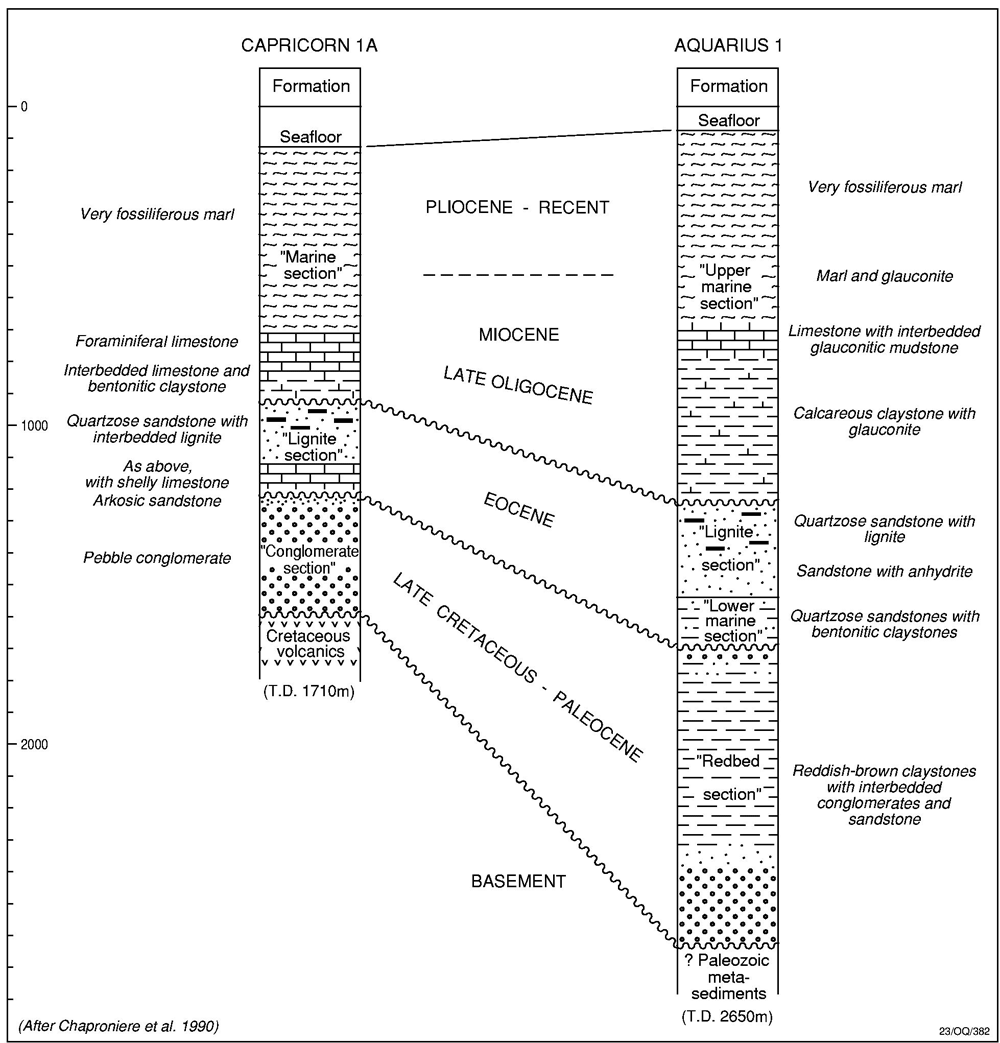Capricorn Basin
Page last updated:27 June 2014
Basin Details and Geological Overview
The Cretaceous to Cainozoic age Capricorn Basin is a northwest to southeast elongate basin located off the southeast coast of Queensland. Water depths range from 3500 metres in the southeast where sediments are up to 4000 metres thick, to 100 metres at the northern basin margin. The basin is poorly explored, with only three wells drilled (all dry) and no significant exploration activity since 1968.
There are two possible models for the tectonic evolution of the Capricorn Basin. One model is that the Capricorn Basin formed during the Late Jurassic-Early Cretaceous from the same extensional event that formed the Townsville and Queensland Basins farther north. An alternative model is that the Capricorn Basin formed in the Late Cretaceous as a failed rift arm at the northern end of the Tasman rift system. This second model divides the basin fill into five basin phases: Late Cretaceous to Early Palaeocene rift phase; Late Palaeocene to Early Eocene late rift phase; Early to Middle Eocene early thermal sag phase; Middle to Late Eocene post-tectonic structural reactivation phase; and a Late Oligocene to Recent late sag/rapid regional subsidence phase. The stratigraphy of the Capricorn Basin consists of continental rift-phase conglomerates and red beds of Late Cretaceous to Early Palaeocene age.
These are overlain by Eocene age mixed marine and continental quartzose sandstones and lignites, in turn overlain by a thick marine sequence of Late Oligocene to Recent age limestone and marl. Although potential reservoirs and traps appear to be present, the petroleum prospectivity is considered low due to a lack of evidence for burial and thermal maturity of potential source rock intervals and by the absence of a proven regional seal.
In addition, most of the Capricorn Basin is located beneath the Great Barrier Reef Marine Park in which petroleum exploration is prohibited.
- ProvExplorer - Capricorn Basin Details and Geological Overview
Basin Summary Table
| State(s) | Queensland | |
| Area (km2) | Offshore | 45,000 |
| Onshore | 0 | |
| Maximum thickness (m) | 5700 | |
| Age Range | Early Cretaceous to Cainozoic. | |
| Basin | Overlies | Palaeozoic metasediments of the Tasman Fold Belt |
| Underlies | - | |
| Subdivisions | ||
| Other | Separated from the Maryborough Basin to the south-west by a basement high, the bunker ridge. | |
| Indicators | Knowledge | Regional geophysical and some well data. |
| Basin type | Divergent margin failed rift | |
| System(s) | Capricorn | |
| Water Depth (m) | 100 - 3500 | |
| Exploration | Status | Frontier |
| Wells | 2 petroleum exploration. | |
| Seismic line-km | Not determined. | |
| Discoveries | Nil | |
| Shows | Nil | |
| HC evidence | - | |
| Geology | Source(s) | Cretaceous rift-fill shales and coals; Paleogene sources are possible in the deepest parts of the basin. |
| Reservoirs | Cretaceous to Paleogene sandstones. | |
| Seals | Intraformational shales. | |
| Trap types | Structural; stratigraphic pinchout also possible. | |
| Palaeogeographic summary | Cretaceous: continental alluvial and fluvial rift-fill; Paleogene: various fluvial, deltaic, coastal and shelf environments, depending upon age and location; Neogene: inner shelf to slope carbonates. | |
| Timing | Oil generation | Neogene if generation has occurred. |
| Gas generation | Neogene if generation has occurred. | |
| Trap formation | Eocene (structural reactivation) | |
| Other key times | Rapid subsidence has occurred since the Pliocene. | |
| Other important information | Most of the Capricorn Basin lies within the Great Barrier Reef Marine Park, in which petroleum exploration activity is prohibited. | |
| Geoscience Australia products available | Hill, 1994. Record 1994/1. | |
Stratigraphy
Key References
| Author | Year | Title |
|---|---|---|
| Benbow, D.D. | 1980 | The petroleum prospects of the Great Barrier Reef region. The Australian Petroleum Exploration Association (APEA) Journal, 20(1), 159-175 |
| Bureau of Resource Sciences | 1996 | Oil and Gas Resources of Australia, 1995 |
| Chaproniere, G.C.H., Pigram, C.J., Symonds, P.A. and Davies, P.J. | 1990 | The northeast Australian margin and adjacent areas – a biostratigraphic review and geohistory analysis. Bureau of Mineral Resources, Australia, Record 1990/7 |
| Ericson, E.K. | 1976 | Capricorn Basin. Economic geology of Australia and Papua New Guinea. Australasian Institute of Mining and Metallurgy, 464-476 |
| Gray, A. R. G. | 1990 | A summary of the petroleum potential of the offshore Queensland continental margin. Queensland Government Mining Journal, v.91, 489-494 |
| Hill, P.J. | 1992 | Capricorn and northern Tasman Basins; structure and depositional systems. Exploration Geophysics, Vol. 23, pp. 153-161. |
| Hill, P.J. | 1994 | Geology and geophysics of the offshore Maryborough, Capricorn and northern Tasman Basins: results of AGSO Survey 91. Canberra, Australian Geological Survey Organisation, Record 1994/1 |
| Palmieri, V. | 1971 | Tertiary subsurface biostratigraphy of the Capricorn Basin. Geological Survey of Queensland, Australia, Report 52 |
| Palmieri, V. | 1974 | Correlation and environmental trends of the subsurface Tertiary Capricorn Basin. Geological Survey of Queensland, Australia, Report 86 |
